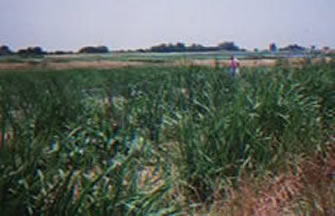 Constructed Wetlands treatment systems are an environmentally friendly technique
of purification of storm and wastewater for today's stringent water quality
standards. Hydrologic routing, through a series of constructed wetlands and
multimedia beds, provides an ideal environment for enhanced physical and natural
microorganism biochemical reactions to occur. No chemicals are required and no
byproducts are created. Only the air, soil, and sunlight are used to remove the
contaminants from the water.
Constructed Wetlands treatment systems are an environmentally friendly technique
of purification of storm and wastewater for today's stringent water quality
standards. Hydrologic routing, through a series of constructed wetlands and
multimedia beds, provides an ideal environment for enhanced physical and natural
microorganism biochemical reactions to occur. No chemicals are required and no
byproducts are created. Only the air, soil, and sunlight are used to remove the
contaminants from the water. J. W. Salm Engineering designs constructed wetlands that feature the Hydrologic Intensive Routing and Processing (HIRP) principal. This principal incorporates proven hydraulic principles along with passive solar design throughout to maximize treatment performance for either storm or wastewater systems. The principal is simple, basically the system mimics the natural hydrologic cycle, which is the mechanism that Mother Nature uses to naturally purify all the Earth's water. The HIRP system is engineered to enhance these naturally occurring processes and provide effective treatment more rapidly than occurs in nature.
The treatment system resembles aesthetically pleasing wetlands, and is often habitat for birds and other wildlife that seek a refuge or food supply in wetland environments. Mosquitoes are not a problem because of constantly fluctuating water levels. Odors are not a problem because the design encourages a constant movement of water through the system. Discharge from the natural tertiary treatment system can be handled by conventional methods or by alternative methods tailored to the site conditions. All treatment is accomplished prior to discharge. This means that the requirements for oversized disposal areas that also perform treatment functions are eliminated. Often, the discharge can be conducted in-ground and on-site in a small, hydro geologically favorable area or discharged directly to surface waters since stream quality parameters can be designed to be met by the HIRP system.
Click Here for Part 2 | Back to Lectures page